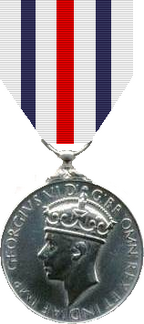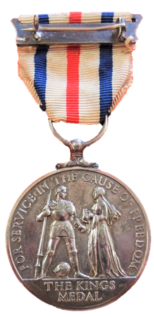King's Medal for Service in the Cause of Freedom
 From Wikipedia the free encyclopedia
From Wikipedia the free encyclopedia
| King's Medal for Service in the Cause of Freedom | |
|---|---|
  King's Medal, obverse and reverse | |
| Type | Civil decoration. |
| Awarded for | Meritorious service in furtherance of the interests of the British Commonwealth in the allied cause |
| Description | Silver disk, 36mm diameter. |
| Presented by | United Kingdom of Great Britain and Northern Ireland |
| Eligibility | Foreign nationals, mostly civilians |
| Campaign(s) | World War II |
| Established | 23 August 1945 |
| Total | 2,539 |
Ribbon bar of the medal | |
| Precedence | |
| Next (higher) | King's Medal for Courage in the Cause of Freedom |
| Related | Allied Subjects' Medal |
The King's Medal for Service in the Cause of Freedom is a British medal instituted by King George VI on 23 August 1945. It was awarded to civilian foreign nationals, mainly of allied countries, who had given meritorious service to further the interests of the British Commonwealth or the Allied cause during World War II. Activities recognised included fund raising for British war relief,[1] scientific research that aided the war effort[2] and organising ambulance services. The medal was awarded 2,539 times.[3]
The medal is silver and 36 millimetres (1.4 in) in diameter. The obverse bears the left facing crowned effigy of King George VI with the inscription 'GEORGIVS VI D:G:BR:OMN:REX ET INDIAE IMP'. The reverse shows a medieval warrior in armour carrying a broken lance, being offered sustenance by a woman. The upper circumference is inscribed 'FOR SERVICE IN THE CAUSE OF FREEDOM', with 'THE KINGS MEDAL' below. The medal was awarded unnamed.[4]
The medal has a ring suspension. The 32 millimetres (1.3 in) wide ribbon is white with a central red stripe, flanked by blue stripes.[5]
Those who helped British military personnel to escape the enemy, return from occupied areas or for other dangerous work for the British or Allied cause during the war were eligible for the King's Medal for Courage in the Cause of Freedom.[6]
Notable recipients
[edit]- Grace Macurdy (1866-1946). Awarded in 1946 for her role in Greek and British war relief.[7]
- John G. Trump (1907-1985). Awarded in 1947 for his research and creation of radar detection technology used during World War II.[8]
- Ann Wood-Kelly (1918-2006). Awarded in 1946 for her service as a ferry pilot with the British Air Transport Auxiliary, she delivering to airfields more than 900 new and repaired aircraft of 75 different types.[9]
References
[edit]- ^ US fund raisers for British war relief included Winthrop W. Aldrich and Grace Macurdy.
- ^ US scientists awardees included: Hoyt C. Hottel, Frederick L. Hovde, Clark B. Millikan, Isidor Isaac Rabi and John G. Trump, uncle of President Donald Trump.
- ^ Treasury: Ceremonial Branch: King's Medal for Service (KMS Series) Records, The National Archives, date accessed 2011-04-04.
- ^ Captain H. Taprell Dorling. Ribbons and Medals. p. 130. Published A.H.Baldwin & Sons, London. 1956.
- ^ John Mussell, ed. (2015). Medal Yearbook 2015. Honiton, Devon: Token Publishing. p. 103. ISBN 978-1908828002.
- ^ King's Medal for Courage in the Cause of Freedom Archived 2006-06-23 at the Wayback Machine, It's an Honour, Department of the Prime Minister and Cabinet, Government of Australia, 22 January 2009, date accessed 2011-04-04
- ^ "A Documentary Chronicle of Vassar College: July 1946".
- ^ "Preliminary Inventory to the Papers of John G. Trump MC.0223". Massachusetts Institute of Technology. Institute Archives and Special Collections. MIT Libraries. Retrieved 10 November 2017.
- ^ "Ann Wood-Kelly, obituary". The Guardian newspapaer. 18 June 2006. Retrieved 7 January 2019.